Indian cuisine has traveled far beyond the borders of its homeland, finding a place in kitchens and restaurants around the world. As Indian food adapts to new environments, it often takes on local influences, creating exciting variations that still stay true to the spirit of the cuisine. One of the most fascinating aspects of Indian food outside India is how it maintains its core principles—such as the use of complex spices and a balance of flavors—while incorporating local ingredients and catering to regional palates.
In many parts of the world, Indian cuisine is synonymous with vegetarian dishes, since a significant portion of the Indian population practices vegetarianism. However, Indian food abroad is not just about vegetarian fare. Many regions outside India also embrace the diverse meat-based dishes that are integral to Indian cuisine, such as tandoori chicken, lamb rogan josh, and fish curries. In traditional Indian cuisine, especially within Hindu communities, beef is generally avoided for cultural and religious reasons. Yet, in some regions and communities outside India, beef can find its way into Indian dishes.
As we explore the best places to find Indian food outside of India, we’ll see how each destination offers a distinct expression of Indian cuisine, shaped by local tastes and ingredients, yet grounded in the culinary heritage of India.
London, UK
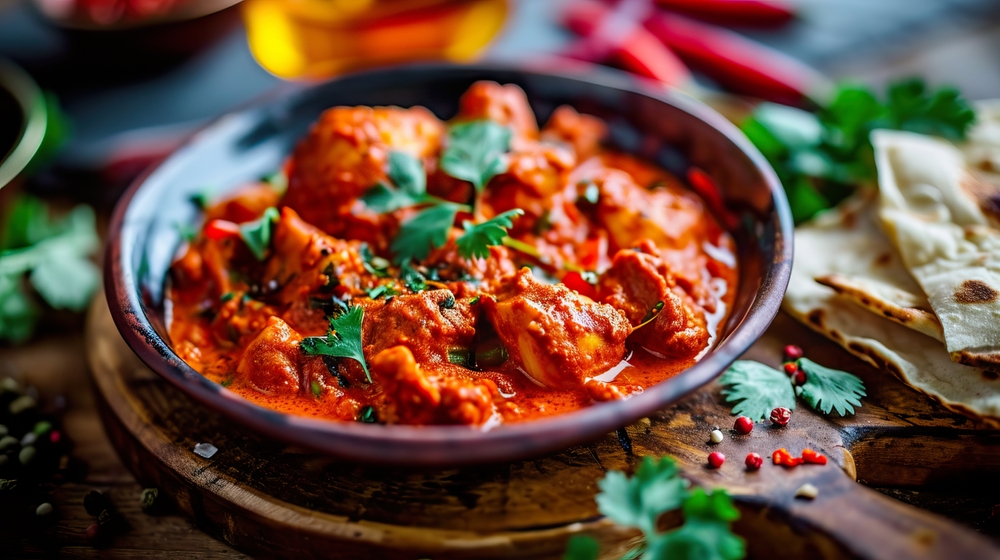
Chicken tikka masala
In London, Indian food isn’t just a dining option—it’s a cultural institution. Over the decades, Indian cuisine has woven itself into the fabric of British life to the extent that going out for Indian food is colloquially referred to as “having a curry.” This phrase captures the deep-rooted affection the British have for Indian flavors, which are now as much a part of the city’s culinary identity as fish and chips.
What makes British Indian food distinct from its counterparts in other countries is the way it has been shaped by the tastes and preferences of the British public. The classic chicken tikka masala — often cited as Britain’s national dish, and believed to have been invented in England — is a great example of how Indian food has been adapted to suit local palates. These dishes tend to feature milder spices, creamier sauces, and a balance of flavors that cater to British tastes while still retaining their Indian roots. The creation of such “Anglo-Indian” dishes has given rise to a distinct style of Indian cuisine that is instantly recognizable and beloved in the UK.
London offers a diverse array of Indian dining experiences, from the high-end restaurants of Mayfair to the bustling food stalls of Brick Lane and Southall. Each neighborhood brings its own character to Indian cuisine, whether it’s the rich, creamy curries that have become staples or the more adventurous regional dishes that reflect the vast diversity of Indian cooking.
New York City, USA
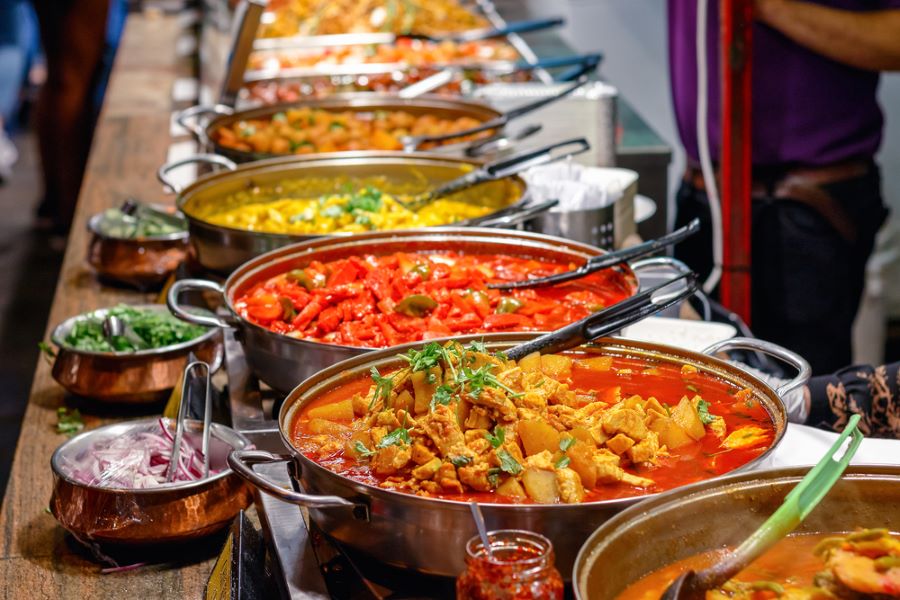
New York City’s Indian food scene is as diverse and dynamic as the city itself. Home to a melting pot of cultures, New York offers a wide range of Indian dining experiences that reflect the city’s vibrant energy and eclectic tastes. From the bustling streets of Curry Hill in Manhattan to the vibrant neighborhoods of Jackson Heights in Queens, Indian cuisine has firmly established itself as a staple in the city’s culinary landscape.
What makes New York City’s Indian food distinct is its incredible diversity and innovation. The city’s Indian restaurants often draw from a variety of regional cuisines within India, offering everything from the spicy, bold flavors of Punjabi dishes to the delicate, aromatic curries of Kerala. This regional diversity is further enriched by the influence of New York’s multicultural environment, where chefs experiment with local ingredients and international flavors, creating dishes that are both rooted in tradition and contemporary in execution.
Toronto, Canada
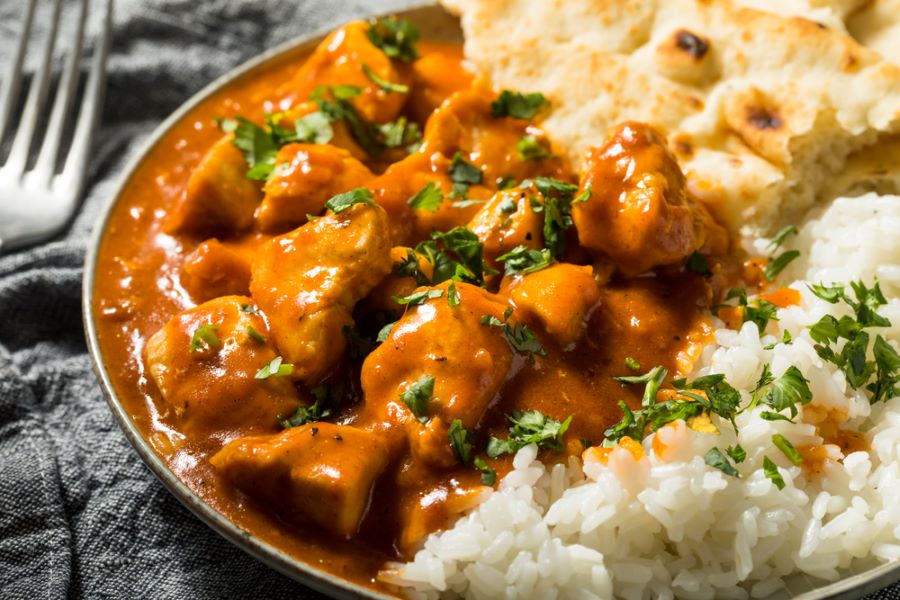
Butter chicken
In Toronto, Indian cuisine is celebrated for its authenticity and its willingness to evolve, making it a vital part of the city’s culinary identity. Toronto’s Indian food scene is a reflection of the city’s renowned diversity and multiculturalism. With a large South Asian population, Toronto boasts a rich variety of Indian restaurants that cater to every taste, from traditional dishes to contemporary interpretations. Toronto’s neighborhoods like Gerrard Street East, often referred to as Little India, and areas in Brampton and Mississauga are particularly known for their concentration of Indian eateries.
What makes Indian food in Toronto stand out is its blending of tradition and innovation. Many of the city’s Indian restaurants stay true to their roots, offering authentic dishes from various regions of India, such as butter chicken from Punjab, dosas from South India, and aromatic biryanis from Hyderabad. However, Toronto’s food scene is also known for its creative fusion, where Indian flavors meet Canadian ingredients and global culinary trends.
Singapore
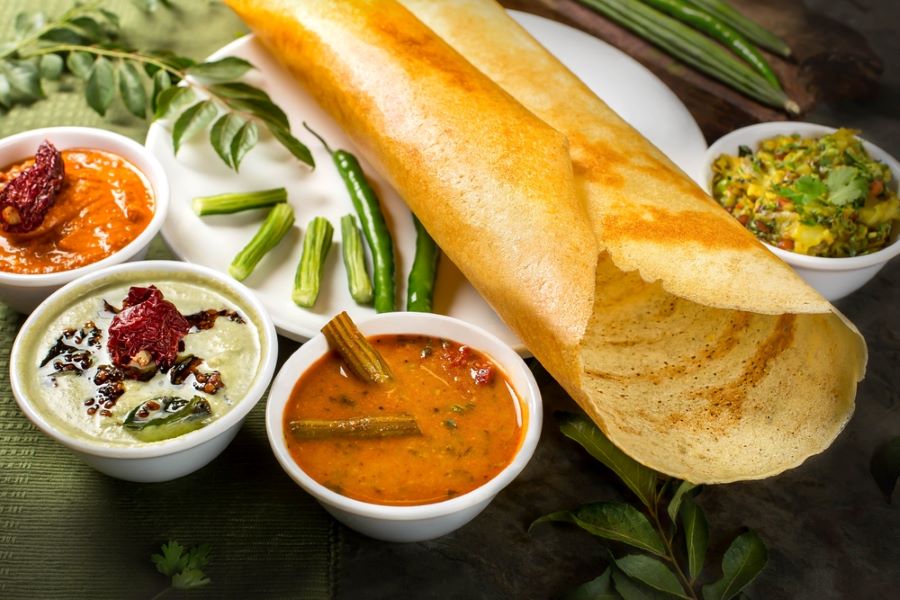
Dosa
Singapore’s Indian food scene reflects the city-state’s multicultural heritage. As home to a substantial Indian population, Singapore offers a wide variety of Indian dishes, ranging from traditional South Indian vegetarian fare to North Indian tandoori delicacies. Singapore’s role as a trading hub has historically brought together different cultures.
In Singapore, you’ll find everything from humble stalls serving up dosa and biryani to high-end restaurants offering modern interpretations of Indian classics. The heart of this culinary experience is in Singapore’s Little India district, where the aromas of spices and the sizzle of street food create an atmosphere reminiscent of the Indian subcontinent. Indian food in Singapore blends traditional Indian techniques with local ingredients such as coconut, pandan, and tropical fruits. In particular, the use of seafood in Indian dishes is more common in Singapore, influenced by the city’s maritime culture and abundant fresh catch.
Melbourne, Australia
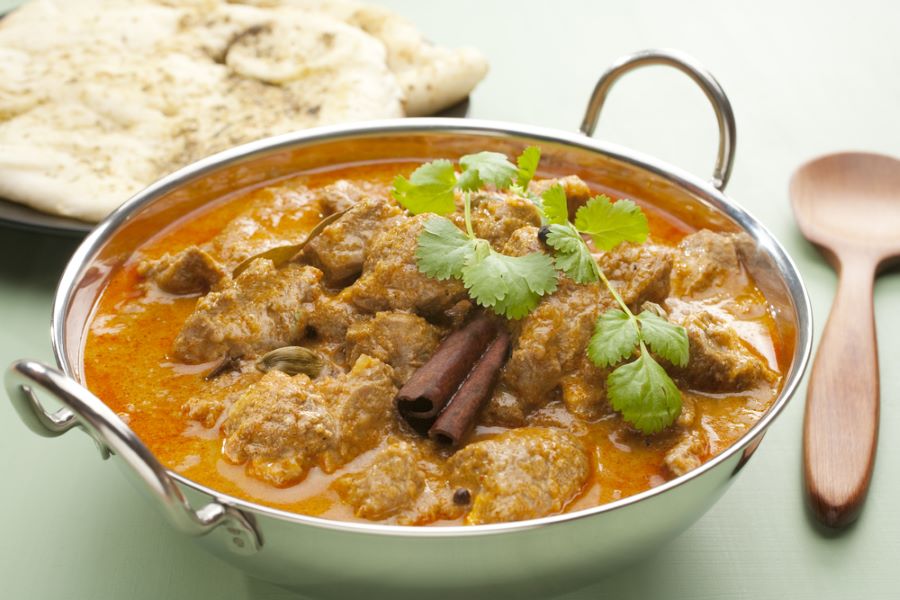
Lamb rogan josh
Melbourne’s food scene is renowned for its diversity, and Indian cuisine has become an essential part of the city’s culinary offerings. With a large Indian community and a general enthusiasm for international flavors, Melbourne offers an impressive range of Indian dining experiences, from casual eateries to upscale restaurants that showcase the full spectrum of Indian cooking. Key areas such as Fitzroy, Docklands, and the CBD are hotspots for Indian food, each offering a variety of options that cater to different preferences, whether you’re looking for hearty street food or refined dining.
Melbourne’s Indian restaurants often emphasize the authenticity of regional flavors, bringing dishes like butter chicken, rogan josh, dosas, and idlis to the forefront. The city’s food culture is also characterized by its openness to experimentation, which has led to innovative takes on traditional dishes. Chefs in Melbourne are known for blending Indian spices and cooking techniques with Australian ingredients like barramundi and native herbs such as lemon myrtle and wattleseed, resulting in a fresh interpretation of Indian cuisine that resonates with local tastes.
Durban, South Africa
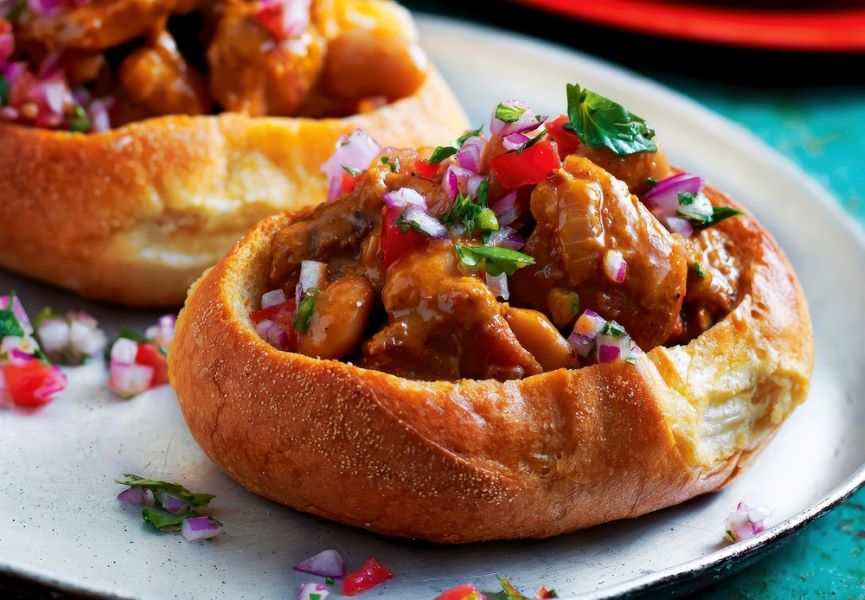
Bunny chow
Durban is often referred to as the “curry capital” of South Africa, and for good reason. With a large Indian population that has been in the region for over a century, Indian cuisine has become deeply embedded in the city’s food culture. Durban’s Indian food scene is known for the distinct dishes that have evolved here, blending traditional Indian flavors with local influences.
One of the most iconic examples of this fusion is Bunny Chow, a dish that originated in Durban. Bunny Chow consists of a hollowed-out loaf of bread filled with curry, typically made with beans, chicken, lamb, or vegetables. It’s a quintessential Durban dish that reflects both Indian culinary techniques and South African innovation. This street food favorite is beloved by locals and visitors alike and is a must-try when exploring the city’s food scene.
Durban’s Indian restaurants often emphasize the flavors of South Indian cuisine, with dishes like dosa, idli, and sambar being popular choices. However, the local Indian food scene is also characterized by its embrace of spicier, richer curries and the use of fresh, locally sourced ingredients such as seafood from the nearby Indian Ocean and tropical fruits.
You Might Also Enjoy: Eating Green on the Go: Navigating Vegan Options While Traveling
Bangkok, Thailand
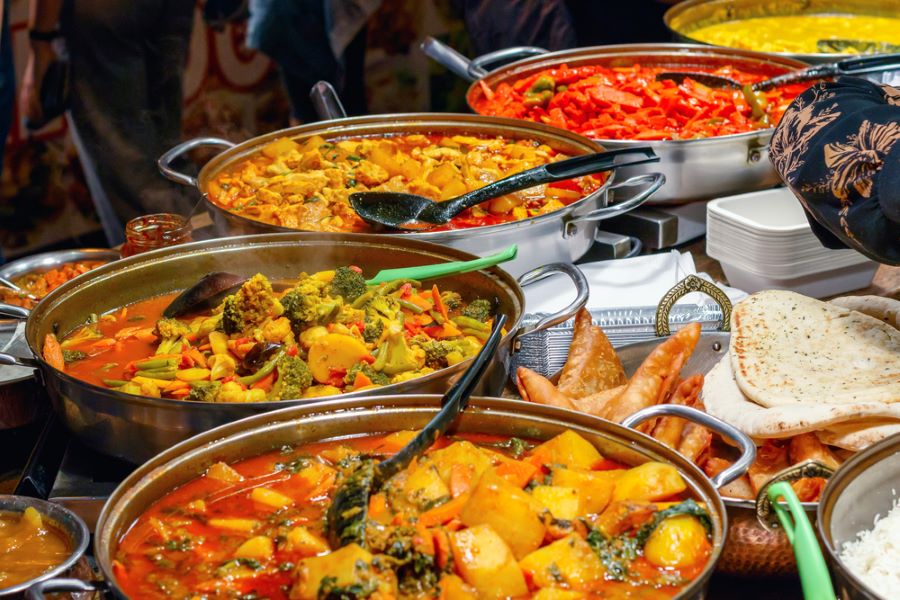
With a longstanding Indian community, Bangkok offers a wide array of Indian dining options that cater to both locals and visitors seeking authentic flavors. Areas like Phahurat, often referred to as Bangkok’s Little India, are home to numerous restaurants and street vendors serving traditional Indian dishes that have been cherished for generations. Bangkok’s Indian food scene spans a broad spectrum, from bustling street stalls dishing out flavorful samosas and spicy chaat to elegant restaurants presenting meticulously crafted thalis.
What distinguishes Indian food in Bangkok is the blend of Indian and Thai culinary traditions. Chefs across the city incorporate local ingredients such as lemongrass, galangal, and Thai basil into classic Indian recipes, crafting dishes that offer familiar tastes with a refreshing twist. This fusion results in offerings like curries infused with Thai spices or naan breads paired with locally inspired dips that might include fish sauce or peanut sauce.
FAQs:
Q: What’s the best time to visit these cities for an Indian food experience?
A: While Indian food is available year-round, visiting during major Indian festivals like Diwali or Holi can enhance your experience, as many restaurants offer special menus and the cities often host cultural events. Additionally, weekends are usually the best time for exploring food markets and neighborhoods known for their Indian cuisine.
Q: How spicy is Indian food in these international cities?
A: The spice level of Indian food can vary depending on the location and restaurant. In general, Indian dishes are adapted to suit local tastes, so you might find milder versions in some places. However, most restaurants are happy to adjust the spice level according to your preference, so don’t hesitate to ask.
Q: Are there any Indian festivals celebrated in these cities?
A: Indian festivals like Diwali and Holi are widely celebrated in these cities, especially in neighborhoods with significant Indian communities, such as London’s Southall, New York’s Jackson Heights, and Toronto’s Gerrard Street East. These festivals often include special food stalls, cultural performances, and community gatherings.
Q: Can I find regional Indian cuisine, such as South Indian or Punjabi, in these cities?
A: Absolutely. Many of the cities mentioned offer a variety of regional Indian cuisines. For instance, Melbourne is known for its South Indian offerings, while London and Toronto have excellent Punjabi restaurants.
Q: Can I find gluten-free Indian food in these cities?
A: Many Indian dishes are naturally gluten-free, including rice-based dishes, curries, and certain snacks. However, it’s always best to ask the restaurant staff to ensure that specific dishes meet gluten-free standards. Cities like New York, Toronto, and Melbourne have a growing number of restaurants that cater to gluten-free diets.
Q: How can I navigate a menu at an Indian restaurant if I’m unfamiliar with the dishes?
A: Don’t hesitate to ask the server for recommendations or explanations of dishes. Most Indian restaurants in these cities cater to a diverse clientele and are accustomed to guiding newcomers through the menu. You can also look for tasting menus or thalis, which offer a variety of small dishes and are a great way to sample different flavors.
Did we leave out your favorite city for Indian food? Tell us about it in the comments below!


What a fantastic exploration of Indian cuisine across the globe! It’s amazing how each city has embraced and adapted Indian flavors, while still honoring the core traditions. From the creamy curries of London to the spicy delights of New York, it’s clear that Indian food has found a home in so many corners of the world!